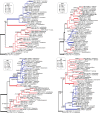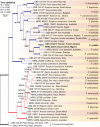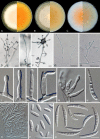Fusarium volatile, a new potential pathogen from a human respiratory sample
- PMID: 32467910
- PMCID: PMC7241678
- DOI: 10.3114/fuse.2019.04.09
Fusarium volatile, a new potential pathogen from a human respiratory sample
Abstract
We describe the isolation and characterization of Fusarium volatile from a bronchoalveolar lavage (BAL) sample of a female patient living in French Guiana with underlying pulmonary infections. Phylogenetic analysis of fragments of the calmodulin (cmdA), translation elongation factor (tef1), RNA polymerase second largest subunit (rpb2), and β-tubulin (tub) loci revealed that strain CBS 143874 was closely related to isolate NRRL 25615, a known but undescribed phylogenetic species belonging to the African clade of the Fusarium fujikuroi species complex. The fungus differed phylogenetically and morphologically from related known species, and is therefore described as the new taxon Fusarium volatile. Antifungal susceptibility testing suggested that the new species is resistant to echinocandins, fluconazole, itraconazole with lower MICs against amphotericin B, voriconazole and posaconazole.
Keywords: FFSC; French Guiana; clinical samples; fungal taxonomy; phylogeny.
© 2019 Westerdijk Fungal Biodiversity Institute.
Figures




Similar articles
-
Redefining species limits in the Fusarium fujikuroi species complex.Persoonia. 2021 Jun;46:129-162. doi: 10.3767/persoonia.2021.46.05. Epub 2021 Mar 30. Persoonia. 2021. PMID: 35935895 Free PMC article.
-
DNA barcoding, MALDI-TOF, and AFLP data support Fusarium ficicrescens as a distinct species within the Fusarium fujikuroi species complex.Fungal Biol. 2016 Feb;120(2):265-78. doi: 10.1016/j.funbio.2015.08.001. Epub 2015 Aug 13. Fungal Biol. 2016. PMID: 26781381
-
New endemic Fusarium species hitch-hiking with pathogenic Fusarium strains causing Panama disease in small-holder banana plots in Indonesia.Persoonia. 2019;43:48-69. doi: 10.3767/persoonia.2019.43.02. Epub 2019 Mar 14. Persoonia. 2019. PMID: 32214497 Free PMC article.
-
Candida and candidaemia. Susceptibility and epidemiology.Dan Med J. 2013 Nov;60(11):B4698. Dan Med J. 2013. PMID: 24192246 Review.
-
Reduced Multidrug Susceptibility Profile Is a Common Feature of Opportunistic Fusarium Species: Fusarium Multi-Drug Resistant Pattern.J Fungi (Basel). 2017 Apr 10;3(2):18. doi: 10.3390/jof3020018. J Fungi (Basel). 2017. PMID: 29371536 Free PMC article. Review.
Cited by
-
Fusarium: more than a node or a foot-shaped basal cell.Stud Mycol. 2021 Aug 17;98:100116. doi: 10.1016/j.simyco.2021.100116. eCollection 2021 Apr. Stud Mycol. 2021. PMID: 34466168 Free PMC article.
-
Fusarium musae from Diseased Bananas and Human Patients: Susceptibility to Fungicides Used in Clinical and Agricultural Settings.J Fungi (Basel). 2021 Sep 21;7(9):784. doi: 10.3390/jof7090784. J Fungi (Basel). 2021. PMID: 34575822 Free PMC article.
-
Multiresistant Fusarium Pathogens on Plants and Humans: Solutions in (from) the Antifungal Pipeline?Infect Drug Resist. 2019 Nov 28;12:3727-3737. doi: 10.2147/IDR.S180912. eCollection 2019. Infect Drug Resist. 2019. PMID: 31819555 Free PMC article. Review.
-
Redefining species limits in the Fusarium fujikuroi species complex.Persoonia. 2021 Jun;46:129-162. doi: 10.3767/persoonia.2021.46.05. Epub 2021 Mar 30. Persoonia. 2021. PMID: 35935895 Free PMC article.
-
What are the 100 most cited fungal genera?Stud Mycol. 2024 Jul;108:1-411. doi: 10.3114/sim.2024.108.01. Epub 2024 Jul 15. Stud Mycol. 2024. PMID: 39100921 Free PMC article.
References
-
- Al-Hatmi AM, Bonifaz A, Ranque R, et al. (2017). Current antifungal treatment of fusariosis. International Journal of Antimicrobial 51: 326–332. - PubMed
-
- Al-Hatmi AM, van Diepeningen AD, Curfs-Breuker I, et al. (2015). Specific antifungal susceptibility profiles of opportunists in the Fusarium fujikuroi complex. Journal of Antimicrobial Chemotherapy 70: 1068–1071. - PubMed
-
- Aoki T, Smith JA, Mount LL, et al. (2013). Fusarium torreyae sp. nov., a pathogen causing canker disease of Florida torreya (Torreya taxifolia), a critically endangered conifer restricted to northern Florida and southwestern Georgia. Mycologia 105: 312–319. - PubMed
LinkOut - more resources
Full Text Sources
